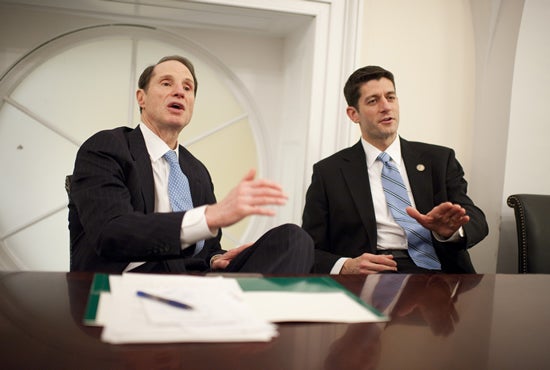Congressman Paul Ryan (R–WI) and Senator Ron Wyden (D–OR) have proposed a new bipartisan framework for structural Medicare reform. It continues the conversation with the American people on a solution to save the popular but financially troubled entitlement program.
While there are differences between the proposal and the Heritage plan outlined in Saving the American Dream, and while their proposal does not go as far or as fast as it should in changing the massive entitlement program, it would establish a premium-support system of financing for Medicare, a variant of a defined contribution toward the health care plans chosen by retirees. This policy is central to the transformation of Medicare into a consumer-based system relying on competition rather than bureaucratic fiat.
Also, similar to the Heritage proposal, government payment for health coverage would be based on competitive bidding among health plans, and Medicare would be put on a budget. This is a crucial improvement in the functioning of the program, because pricing would be determined by market competition rather than by Washington bureaucrats.
The Ryan-Wyden proposal is the latest in a long tradition of bipartisan efforts to reform Medicare on the basis of a defined contribution for financing, following the proposals of Breaux–Thomas in 1999 and the Gephardt–Stockman in 1983. Premium support offers a way to reduce future Medicare costs without draconian cuts to doctors and hospitals, sharp tax increases or dramatic hikes in Medicare premiums. It would also expand options for beneficiaries, who would secure government contributions to enable them to purchase insurance, either from a private plan or traditional Medicare.
Payment for health plans would be based on a process of competitive market bidding. Private plans, as well as traditional fee-for-service Medicare, would bid by offering a package of Medicare benefits for a certain price. The Ryan–Wyden proposal would establish a benchmark for plan payment based on the second-lowest-plan bid. Beneficiaries would be free to choose the benefit packages of plans above the benchmark payment, but they would pay the difference between the government payment and the higher-priced plan. On the other hand, if a beneficiary chooses a cheaper plan, they would pocket the difference as personal savings.
With competition on a level playing field, health plans would have powerful market incentives to offer a variety of benefits at the lowest possible cost. This is the beauty and benefit of the free market. Studies by the Congressional Budget Office and academics such as Bryan Dowd and Roger Feldman estimate that these changes can result in substantial savings.
Under the Ryan–Wyden proposal, all Medicare beneficiaries would be guaranteed the level of benefits offered in traditional Medicare. But the financing of the system would be improved by replacing the rigid system of administrative pricing and price controls on medical services. Medicare bureaucrats routinely set prices too high and too low, resulting in windfalls for some providers or a shortfall in services in some areas. Intense competition on a level playing field among health plans ensures that they would bid to offer services closer to the actual costs of providing those services.
Similarities with the Heritage Proposal
Like Heritage’s Saving the American Dream (see also The Second Stage of Medicare Reform: Moving to a Premium Support Program), private plans in the Ryan–Wyden proposal would be permitted to compete head to head with traditional Medicare. Like the Heritage proposal, the reform would also include a risk-adjustment mechanism to ensure that enrollees who are older and sicker could stay in plans of their choice and that those plans could remain in the market.
Ryan–Wyden would provide higher payment to plans that have a higher number of high-risk and sicker patients. Like the Heritage proposal, Ryan–Wyden would also provide lower taxpayer subsidies to high-income beneficiaries by requiring these beneficiaries to pay higher premiums. Medicare is a highly subsidized government program, and younger taxpayers should not subsidize Medicare for those who can afford to pay their own share.
Finally, like the Heritage plan, the Ryan–Wyden proposal would put Medicare on a budget, just like other government programs. Medicare spending would no longer be on automatic pilot. In the Heritage plan, Medicare spending would be indexed to price increases (CPI+1 percent), while in the Ryan–Wyden proposal, the spending is indexed to economic growth (GDP +1 percent). If Medicare expenditures exceed economic growth, Ryan–Wyden would require a variety of congressional measures to slow the growth in Medicare costs.
Ensuring that Medicare has a fixed budget instead of being an open-ended entitlement is essential to fiscal discipline. It is important that if congressional action is needed, actions are not taken that weaken the competitive model. If Medicare beneficiaries have to pay higher premiums, for example, they would also have strong economic incentives to choose lower-cost plans and spend wisely.
Making Further Improvements
Since the Ryan–Wyden proposal is based on working principles, there are still many policy questions to resolve. For example, it is silent on the future of Obamacare. Make no mistake: Structural Medicare reform should begin after full repeal of Obamacare. Furthermore, given the depths of our fiscal crisis, the proposal is slow to take effect. The Heritage proposal transitions to premium support beginning in 2016; Ryan–Wyden does not begin until 2022, the same date embodied in the House budget resolution.
Nonetheless, Ryan–Wyden continues the conversation about the need for fundamental structural Medicare reform. Trying to save Medicare through more government price controls will not do. Converting the outdated Medicare program into a premium-support model is the best and more honest way forward.
